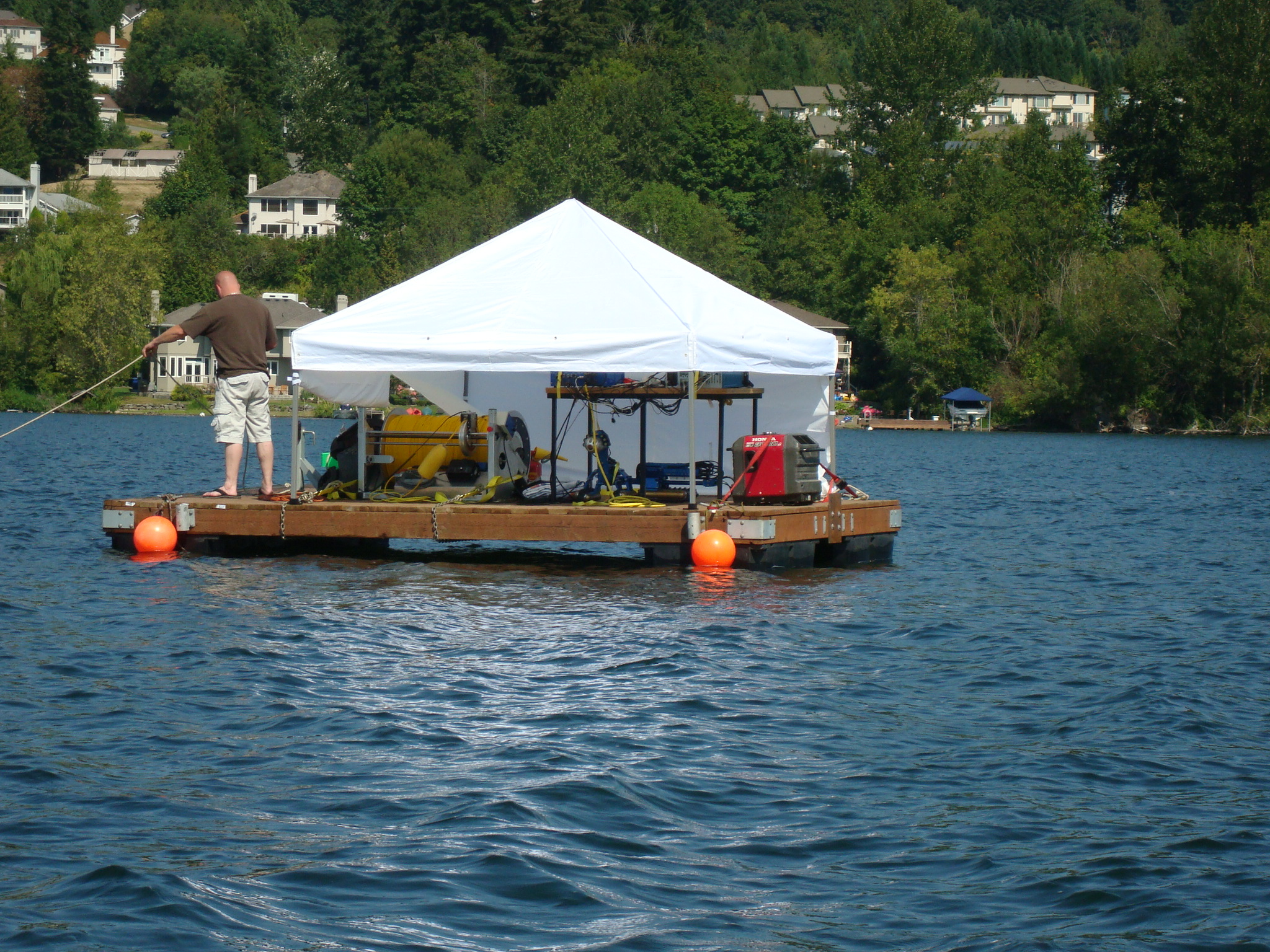March 2012, Vol. 67 No. 3
Features
Underwater Sewer Pipe Inspection

In 2011, Interactive Pipe Inspection (IPI) completed inspection of more than 50,000 feet of 30- and 48-inch diameter sanitary sewer lines for King County, WA.
What sets the project apart from routine pipeline inspections is that the sewer lines were underwater in Lake Washington and Lake Sammamish.
IPI specializes in pipe inspection and assessment services using panoramic pipe inspection technology that provides a 360-degree look at inside pipe surfaces and detailed information far beyond the capabilities of conventional pan-and-rotate inspection cameras and equipment.
Sewer lines inspected were:
• Issaquah Interceptor, 14,673 feet;
• Holmes Point Trunk,11,665 feet; and
• Kenmore Interceptor, 24,497 feet.
Bryce James, IPI manager, said the sewer lines were laid more than a half century ago, initially flowing directly into the waters of the lakes. In the mid 1960’s, the lines were diverted from pump stations along the lakes into interceptors and trunks sending raw sewage to treatment plants.
The inspection equipment used was an Inuktun VT300 Versatrax crawler/camera system with multi-sensor capability, said James, adding that IPI is only one of four companies in the United States with this inspection system.
With three cameras and multiple sensors, the Inuktun Versatrax 300 is the solution to long-range pipe inspection, said James.
“With it,” he explained, “IPI is able to inspect more than 6,000 feet of pipe in a single run, the first time this has been done in the United States using a high-resolution, 525-line resolution CCTV camera. This capability not only saved the crew the time and coordination effort of moving the dock to many different sites, but also saved King County money, compared to costs of previous inspections using equipment that would have had to make many, much-shorter runs.”
To implement pipe inspections with the VT300 in the underwater work environment required two experienced IPI crews, supported by certified divers, a portable dock, boats, a caisson to access underwater manholes and other support equipment.
Special procedure devised (subhed)
James summarized the steps necessary to perform the inspections. The first step was preparing the portable dock to use as a float and home base.
“We were unable to use a barge because the manholes in the lakes were too close to the shoreline,” he said. “The dock was outfitted with a cover for protection against both sun and rain, and then the equipment was brought onboard. Tether reel, electronic control and recording equipment were set up on the dock.
IPI spilt personnel into two crews. One crew operated from the base dock. Using project maps, the crew would take a boat to the position marking a manhole and a certified diver would locate the underwater manhole and mark its spot with a buoy.
The second crew in another boat then would tow a 48-inch caisson supplied by King County to the buoy and lower the caisson into the water. A diver would help guide the caisson into position on the manhole platform, attach it to the platform, and water would be pumped out of it to form a sealed “chimney” to access the manhole cover and pipes. Once in place, safety floats were attached to the caisson.
The first (inspection) crew then moved into position at the caisson. The camera component was lowered down the chimney/caisson and into the pipe and the inspection process was initiated. IPI had to invent and manufacture special winches to attach to the caisson in order to lower the camera into the pipe.
The Versatrax 300 moved through the pipe, and its 360 degree findings were relayed in real time to the home base equipment on the dock and recorded for future inspection diagnostics. A portable hard drive was used to store the information and then delivered to the county.
Data collection (subhed)
Infrastructure Technologies’ I.T.pipes software was used to collect the inspection data and document findings. I.T.pipes database and application were designed to seamlessly integrate with other applications, including ESRI GIS. I.T.pipes is a certified NASSCO PACP software.
After inspection of a section of pipe was completed, the second crew returned, the diver unlocked the caisson, it was filled with water, an air plug was inserted and inflated, and the caisson was towed to the next site where the process would be repeated.
Being able to utilize information from King County’s maps directly with I.T.pipes data was instrumental in finding several previously unknown problems.
“For example,” James said, “we located a missing manhole at Holmes Point by linking the map with the inspection data. We also found multiple occurrences of incorrect pipe sizes and lengths that we immediately corrected in the geo database, allowing us to track the project. These findings were corrected within IPI’s version of King County’s map files, based on the communication between I.T.pipes and the GIS.”
James said the reports are clear and easy to understand by anyone needing to evaluate them.
“Using I.T.pipes GIS view tool,” he said, “we not only have a free read-only version of the software to provide to King County for viewing, but also have a link between our maps and the viewer. This allows us to select a line on the map and instantly view the associated detail, video, snapshots and PDF reports. We can select any lines inside I.T.pipes that meet select criteria and highlight those same lines in the GIS. Or we can select a line in the GIS and launch I.T.pipes to view the detail and make modifications or further notes.”
Over the course of the project, IPI inspected 105 manhole sections of pipe with 13 deployments averaging more than 3,910 feet each, said James. Each deployment was started and finished on the same day. Environmental conditions and weather changes posed logistical challenges every day. At times, harsh weather brought lake conditions that required work to be postponed.
IPI had two project managers on site: James and Pat Shepp.
The project was done under a five year inspection contract between IPI and King County which is a part of the county’s 15-year inspection cycle of these lake lines.
King County’s Regional Wastewater Conveyance and Treatment System serves approximately 1.5 million people in a 420-square-mile service area which includes most urban areas of King County and parts of south Snohomish County and northeast Pierce County. The system includes more than 350 miles of pipe, three large wastewater treatment plants, two smaller plants and four combined sewer overflow treatment facilities.
Interactive Pipe Inspection was established in 2009 as a corporation specializing in advanced technology applications for the inspection of underground pipe systems to multi-national markets. IPI began as a division of Pipe Experts LLC, a provider of trenchless technology services for more than 30 years. The company also has introduced a method of panoramic inspection of manholes. IPI is based in Tumwater, WA.
“The ability to provide engineers and municipalities with measurable data is a major benefit of the panoramic technology,” said James. “We believe it is the future of pipe inspection and that future is IPI.”
FOR MORE INFO:
Interactive Pipe Inspection, (800) 850-3043, http://ipi-pipe.com
Inuktun, (877) 468-5886, http://inuktun.com




Comments